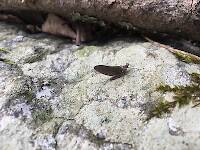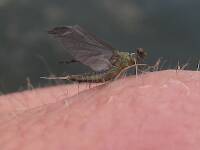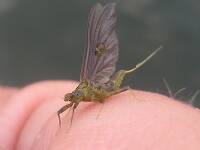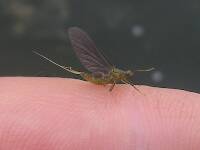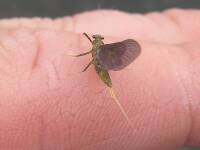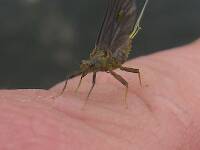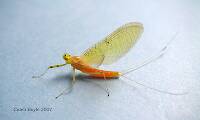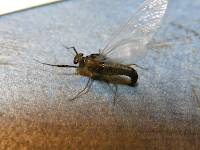
Hex Mayflies
Hexagenia limbata
The famous nocturnal Hex hatch of the Midwest (and a few other lucky locations) stirs to the surface mythically large brown trout that only touch streamers for the rest of the year.
Featured on the forum

This dun emerged from a mature nymph on my desk. Unfortunately its wings didn't perfectly dry out.

Troutnut is a project started in 2003 by salmonid ecologist Jason "Troutnut" Neuswanger to help anglers and
fly tyers unabashedly embrace the entomological side of the sport. Learn more about Troutnut or
support the project for an enhanced experience here.
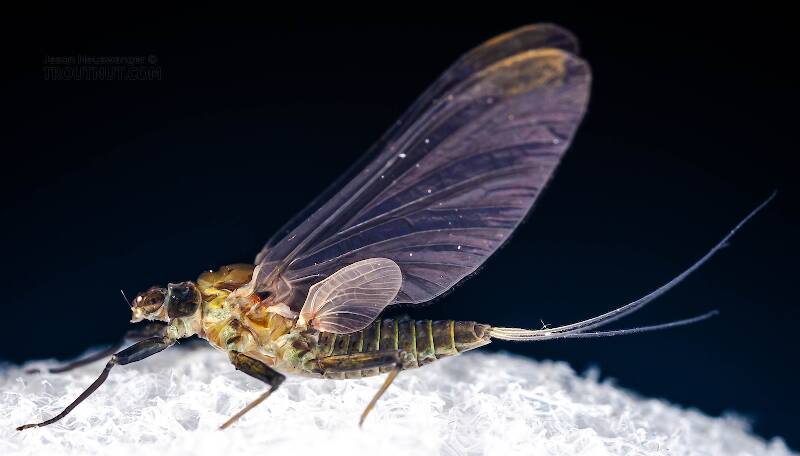
I don't know for sure that this is Drunella tuberculata, but that's my best guess for now.
It certainly has a different look and much more robust body shape from Drunella lata duns I photographed a couple weeks earlier, so I doubt it's that species. Using distribution records to eliminate other choices narrows this down to Drunella tuberculata or Drunella walkeri.
Markings described for the abdominal sternites of the male spinner of Drunella tuberculata are suspiciously similar to those on this female dun. Also, this dun is 9.5mm long (my ruler pic isn't very good, but I'm basing this on measuring the real thing). The size range given in the old Allen & Edmunds keys for walkeri females is 7-8mm, while tuberculata is 9-11mm. For these reasons I'm sticking it in tuberculata for now.
This is the only Drunella mayfly I saw all day. I scooped it off the water as it emerged at around 7pm from a big Catskill tailwater.
It certainly has a different look and much more robust body shape from Drunella lata duns I photographed a couple weeks earlier, so I doubt it's that species. Using distribution records to eliminate other choices narrows this down to Drunella tuberculata or Drunella walkeri.
Markings described for the abdominal sternites of the male spinner of Drunella tuberculata are suspiciously similar to those on this female dun. Also, this dun is 9.5mm long (my ruler pic isn't very good, but I'm basing this on measuring the real thing). The size range given in the old Allen & Edmunds keys for walkeri females is 7-8mm, while tuberculata is 9-11mm. For these reasons I'm sticking it in tuberculata for now.
This is the only Drunella mayfly I saw all day. I scooped it off the water as it emerged at around 7pm from a big Catskill tailwater.
Troutnut on Jun 8, 2007June 8th, 2007, 10:52 am EDT
I'm a bit puzzled about this one. See the specimen description for details. I know female duns are awful for identification, but this is the only one of its species I could find. Would any of you Ephemerellid experts (Konchu!!) care to take a guess?
Jason Neuswanger, Ph.D.
Troutnut and salmonid ecologist
Troutnut and salmonid ecologist
GONZO on Jun 8, 2007June 8th, 2007, 11:58 am EDT
Could be tuberculata, but distinguishing between that and walkeri is something I'll leave in Konchu's capable hands. However, I don't think that the size difference suggested by Allen and Edmunds is valid.
Troutnut on Jun 8, 2007June 8th, 2007, 12:01 pm EDT
I don't think that the size difference suggested by Allen and Edmunds is valid.
You're probably right. That's a pretty outdated paper. It's just the best hint I've got to go on for now.
Jason Neuswanger, Ph.D.
Troutnut and salmonid ecologist
Troutnut and salmonid ecologist
GONZO on Jun 8, 2007June 8th, 2007, 1:07 pm EDT
I just reread Konchu's paper on the Drunella revisions, hoping to find something more definitive. It mostly helped to confirm that distinguishing between tuberculata, walkeri, and allegheniensis is very difficult due to variability. I suppose it's appropriate to rule out allegheniensis based on distribution. I also thought that the early hatch date might rule out walkeri, but apparently there can be wide discrepancies between different groups or cohorts even within the species. (And an evening Drunella emergence is something I've only witnessed on the Delaware.)
Konchu on Jun 9, 2007June 9th, 2007, 2:03 am EDT
Too early in the morning to put a species name on that specimen.
Walkeri/tuberculata are likely candidates. I'd lean towards walkeri, but I'd never put it in writing on a det label.
Walkeri/tuberculata are likely candidates. I'd lean towards walkeri, but I'd never put it in writing on a det label.
Troutnut on Jun 9, 2007June 9th, 2007, 4:19 am EDT
What do you guys think of the protrusion below the right eye on the second picture down? That's an interesting feature in a dun.
Jason Neuswanger, Ph.D.
Troutnut and salmonid ecologist
Troutnut and salmonid ecologist
GONZO on Jun 9, 2007June 9th, 2007, 4:27 am EDT
It appears to have lost its righthand antenna, so I took that protrusion to be the healed remains. Perhaps the damage occurred in an earlier larval stage.
Taxon on Jun 9, 2007June 9th, 2007, 5:32 am EDT
Anyone know on which lifestage(s) and anatomic location(s) the tubercle(s) (for which this species in named) appear(s)? Once Jason got me looking closely at the second photo, I couldn't help but wonder about that interesting midline nodule on top of the head, or perhaps the pronotum.
GONZO on Sep 21, 2009September 21st, 2009, 10:53 am EDT
Konchu's mention of D. tuberculata in the Smokies led me back to this old thread and Roger's question about the etymology of the name. Anna Haven Morgan originally described the species from a nymph found in the upper part of Fall Creek near Ithaca, NY. Although she didn't explain the etymology, she did refer to "two large erect tubercles on the occiput" of the head, and she also illustrates these in her paper.
Quick Reply
Related Discussions
Topic
Replies
Last Reply
6
Jan 4, 2010
by Konchu
by Konchu
10
Sep 12, 2010
by Martinlf
by Martinlf
2
Feb 6, 2017
by Crepuscular
by Crepuscular





